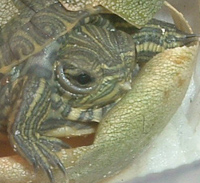Egg tooth

An egg tooth is a structure that young animals use to break open the egg shell from the inside when they hatch . In lizards and snakes , it is a modified tooth on the intermaxillary bone . Geckos often have double teeth.
In birds , turtles , crocodiles and monotons , the same function is assumed by a strongly horny elevation on the beak or the tip of the snout. This is also called Eischwiele called, to distinguish them from the real Eizähnen.
Egg teeth or egg calluses are usually shed or receded shortly after hatching.
In the case of insects, too, especially dragonflies , the structures with which they free themselves from the eggs are referred to as egg teeth in analogy to the egg teeth of birds. However, they are saw-like sagittal ridges on the larvae 's head.
supporting documents
- ^ Hansruedie Wildermuth: The falcon dragonflies in Europe. (= Neue Brehm-Bücherei. Volume 653). Westarp Sciences, Hohenwarsleben 2008, p. 62.
literature
- Bairbre O'Malley: Clinical Anatomy and Physiology in Small Pets, Birds, Reptiles, and Amphibians . Elsevier, Urban & Fischer-Verlag, 2008, ISBN 978-3-437-58260-8 .
- Milton Hildebrand, George E. Goslow, C Distler: Comparative and functional anatomy of the vertebrates . Springer, 2003, ISBN 3-540-00757-1 .
